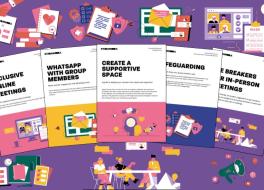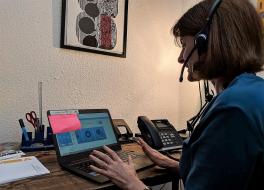How you can improve your organisation's customer journeys for people who stammer.
If you are providing a public service or running a business, you have a legal duty under the Equality Act and the Disability Discrimination Act (NI) to ensure your services are accessible for people with disabilities and differences. The Financial Conduct Authority states that companies in the financial sector should have processes in place that consider the needs of vulnerable customers.
This page sets out the barriers people who stammer face when using services, and suggests ways you can remove these to make your service is accessible for those with spoken communication difficulties.
Introduction
You may not have met anyone who stammers or thought about how disfluency can impact your customers' journeys. But at least 1% of adults stammer*. We estimate that 43 million calls were made by people who stammer last year, as set out in our 2025 report on phone accessibility (which you can download below).
Our report, as part of our End the Phone Call Nightmares campaign, lays bare the barriers callers who stammer face: being hung up on, talked over, rushed and misunderstood. Or not being able to get past voice recognition systems.
Add in those who might have disfluent speech such as those with Parkinson's or who've had a stroke, and you can see why a review is important.
What is Stammering?
Stammering is different to the occasional repetition or hesitation that everybody experiences.
It's when someone repeats, prolongs, or has silent blocks when trying to say sounds or words. It can be accompanied by sometimes intense tension as they struggle to get words out.
We don't know exactly what causes stammering, but research indicates that it is primarily neurological. This means that the way speech is produced in the brain is different for people who stammer. Stammering is the way some people talk. That's all.
- People do not stammer because they are less intelligent or have a nervous personality.
- Patterns of stammering vary from person to person.
- Stammering fluctuates. It often varies from situation to situation as well as over time. That's normal.
- You may not know that a person stammers. Some people will mask their stammer, and swap and avoid words, even speaking situations to sound fluent.
- It can be exhausting and stressful for a person who stammers to try to speak fluently.
You can find our more in our About Stammering section.
Things to consider
Here are some things you might not have considered about your customers or service users who stammer:
1. Hidden Stammering
Many people will swap words or avoid situations to mask their stammer because of the negative responses they've received in the past.
So, while you may not pick up on those pauses, swapped words and the exhausting preparation involved in sounding fluent, the person stammers. You just don't hear it because they've gone to great lengths to hide it. That doesn't stop their customer journey being tough to navigate.
2. Poor Training
Those who stammer openly face negative experiences every day in stores and restaurants or when calling customer helplines.
When staff don't recognise stammering or know how to respond, they may laugh, smirk or make a joke. Especially when faced with someone taking longer to say their name. Or put the phone down, rush the customer to speak more quickly, or finish their sentences for them.
3. Talking Under Pressure
A mundane situation can be a source of dread. Someone who stammers may order something they find easier to say rather than something they want. Or worry intensely about holding up a queue or spend a sleepless night before booking an appointment. Some will avoid such situations - and buy a coffee where they don't have to give a name. Or not open that account.
4. Key Words
Calls with questions requiring words that can't be swapped – such as name, address, date of birth - can be the hardest for those who stammer. In anticipation, they may decide not to make the call at all. Or spend hours or days worrying about it.
5. 'Silent' Calls
Starting phone calls can be especially difficult for people who stammer, eg when saying "Hello". Your customer or service user might get through on a call and then 'block' on a word, where no sounds come out. Call agents might think there's a poor connection, or it's a nuisance call, and hang up. Download our 'Silence on the line' guide below for some scripts you can use.
6. Wrong Assumptions
We've come across calls with banks and customer services where stammering has been misinterpreted as nervousness or even lying. The outcome of which can be significant for that customer.
7. Voice recognition
Our members have told us how voice recognition systems used by banks, insurance companies,etc, often don't give them time to say what they want to say. If they block and get any sound out, systems can cut them off with a 'I didn't recognise that, please try again', so they get stuck in a loop. Others have complained about systems not recognising their stammered speech.
Simple changes can improve overall customer satisfaction, sales, traffic and missed calls. Whether that's by amendments to procedures, added communication channels or training.
Customer & user journeys
If you want to ensure that your goods and services are available for everyone, look at the way in which customers will be in contact throughout their time with you, in person or online or via the phone.
1. Flexible communication channels
Ensure there's more than one way for your customers to communicate with you. Speaking is just one of those options.
For example, if you need a name on a coffee cup, offer customers the option to write their names on a cup themselves, rather than saying it.
2. Voice Recognition
If you use a voice-automated system as a channel for customers or service users, provide an accessible alternative. This way, customers with speech differences have the option to bypass the voice-automated service and speak directly with a call handler who is trained in communication differences. Or let them use their number pad to input their answers.
Make sure the technology allows customers to speak at their own pace and without time limits. Offer options to pause and resume the call.
3. Implement a profile flag feature
Implement a flag for 'communication differences' or 'stammering', which can be added to the customer or service user's profile with their consent. Invite your customers to register their communication preferences with you.
4. Alternative ID Procedures
People who stammer often find those words which can't be swapped or changed the most difficult to say. This can include their name, address, date of birth, account numbers, etc.
Ensure that your call handlers are aware of this and develop alternative ID procedures that your customers can opt in to.
5. Fraud detection
A.I. or human fraud detection systems may misidentify stammering as hesitancy, being unsure or lying. Find out whether your fraud detection systems use speech disfluency or pauses as a marker for fraud.
Use customer flagging procedures to override this particular marker for customers who stammer.
6. Call Back
Offer a call-back service at a set time to allow people who stammer to prepare for the call. Keep to the agreed time for the call.
Dos & don'ts
People who stammer often find those words which can't be swapped or changed (like name, address, date of birth), the most difficult to say, so expect this and be patient. Don't joke and suggest that the customer has forgotten their name.
Some people who stammer experience more stammering when they start to speak and less stammering as the conversation progresses. Or they may stammer more on some days than others. That's normal for stammering.
Here are some dos and don'ts when talking to a customer by phone OR in person:
Don't
1. Interrupt, speak over or finish a sentence
Allow people to finish their sentences at their own pace. Guessing what they're trying to say is well-meant, but people who stammer often find it rude, humiliating and unhelpful.
2. Mistake stammering for something else
Hesitation, pausing or changing words doesn't indicate nervousness or an attempt to avoid a question for people who stammer. It's just stammering. Nothing more.
3. Hang up
If you pick up the phone and hear nothing, don't hang up. Give the caller time to speak. If you're unsure whether there's someone there or worried that it's a prank call, try our suggested script for silent calls below.
Do
1. Wait
Give people enough time to say what they need. Actively encourage customers to take their time. Rushing customers who stammer tends to make it harder for them to speak.
2. Focus on the content
Focus on what your customer is saying, not how they say it.
3. Make space for stammering
If your customer is working hard to speak, it really is just about waiting patiently. You don't need to say anything about the stammering unless the person mentions it or seems very upset. If so, when they have finished what they're saying you could say something like, 'I want you to know that you can take as long you need to speak. If I can help in any way, please let me know.'
For more tips, see In Conversation With Someone Who Stammers.
Silent calls
Some people who stammer find it very hard to speak, particularly at the beginning of a call.
If a call is silent, or if there are sounds but no words, it may be a caller who stammers who is 'blocking' and working incredibly hard to get their words out. To create space for them to speak you can use a script similar to the following:
You: "Welcome to [your company's name]. How can we help?"
Silent or occasional sounds.
Wait at least 15 seconds, then…
You:"I know it’s difficult for some people to start speaking on the phone. I can't hear you at the moment, but I’m happy to wait."
Silent or occasional sounds.
After another 30 seconds…
You: "I can't hear you and I'm not sure if you can hear me or not. If you'd like me to stay on the line, can you tap on your phone twice, just so that I know you're there?"
If caller taps twice, you know to keep waiting and repeat the cycle one more time. If no tap OR if the caller still hasn't spoken after you've been through the cycle twice, wait another 20 seconds and then say something like:
You: "I'm not sure if you're there and want to talk to us or not. I'm going to finish the call now, but you're very welcome to call us back. If the phone is difficult for you and you'd prefer to chat in a different way, you can also contact us by [outline alternative contact methods]. Thank you for calling and we really hope to chat with you next time. Bye."
End the call.
Training & Workshops
Train call handlers, till operators, shop floor staff, security, and all those dealing with your customers to recognise stammering and to listen empathetically, patiently, and without interruption to customers who stammer.
We can help...
Phone call workshops
In 2025-26, we're running free online workshops for organisations to help them improve phone contact with callers who stammer. See the bottom of our Getting Phone Calls Right page for a list of workshop dates.
Tailored Training
We also offer training tailored to meet the specific needs of the organisation, which can be conducted remotely or in person. Email us at training@stamma.org Or you can call our helpline for free on 0808 802 0002 or start a webchat.
Additional actions
Other ways of providing an accessible environment for people who stammer include:
Feedback
Encourage feedback from customers with communication differences and use it to improve your services. This might include providing additional staff training, introducing new technologies and communication tools, and reviewing and adapting policies and procedures to better meet the needs of customers who stammer.
Share information on accessibility on your website
Publish information on accessibility in general, including communication differences and stammering. This can help your customers with communication differences feel acknowledged and know about your services.
You could include information about the availability of assistive technologies or accommodations for people who stammer, such as offering extended time for phone calls or allowing customers to select their preferred channels of communication.
Set up a network
Consider setting up a staff network for people who stammer within your company. Get in touch with communities@stamma.org and we'll help you get started.
About STAMMA
We exist to create a world that makes space for people who stammer. Where a stammer is embraced as just a difference.
We have been representing people who stammer since 1978. Our members include those who stammer and those who don't. It includes those who are proud to stammer, those who would rather be fluent and all the shades of opinion in between. Read more about Our Mission.
Stammering is variable and not all the information in this document will apply to everyone. However, flexible communication options will benefit many, not just those who stammer.
We'd love to help make your business more inclusive and improve your customer experiences with tailored staff training and guidance. Email us at employmentsupport@stamma.org
Video
Watch our video 'Stammering, diversity and inclusion' below.



































